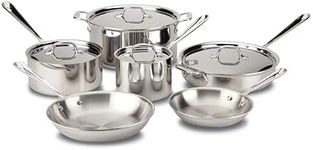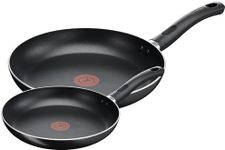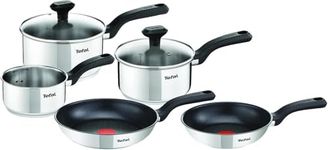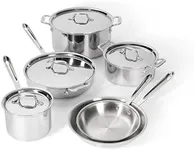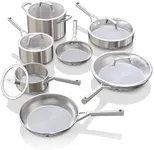Buying Guide for the Best Pan Sets
Choosing the right pan set can significantly enhance your cooking experience. A good pan set should be versatile, durable, and suited to your specific cooking needs. When selecting a pan set, consider the material, size, weight, and compatibility with your stove. Each of these factors can affect the performance and convenience of your cookware. Here are some key specifications to consider when choosing a pan set:MaterialThe material of the pans is crucial as it affects heat distribution, durability, and ease of cleaning. Common materials include stainless steel, non-stick, cast iron, and copper. Stainless steel is durable and resistant to rust, making it a good all-around choice. Non-stick pans are great for easy cleanup and cooking with less oil, but they may not last as long. Cast iron retains heat well and is excellent for searing, but it is heavy and requires special care. Copper pans offer superior heat conductivity but can be expensive and require regular maintenance. Choose a material based on your cooking habits and preferences.
SizePan sets typically come with a variety of sizes to accommodate different cooking tasks. Common sizes include small (8-10 inches), medium (10-12 inches), and large (12-14 inches). Smaller pans are ideal for single servings or small dishes, while larger pans are better for family meals or cooking larger quantities. Consider the types of meals you frequently prepare and choose a set that includes the sizes you will use most often.
WeightThe weight of the pans can affect how easy they are to handle. Heavier pans, like those made from cast iron, provide excellent heat retention and even cooking but can be cumbersome to lift and maneuver. Lighter pans, such as those made from aluminum or non-stick materials, are easier to handle but may not offer the same level of heat distribution. If you prefer ease of use and quick cooking, lighter pans may be more suitable. If you prioritize cooking performance and durability, heavier pans might be a better choice.
CompatibilityEnsure that the pan set you choose is compatible with your stove type. Some materials, like stainless steel and cast iron, work well with all stove types, including induction. Non-stick and aluminum pans may not be suitable for induction stoves unless they have a magnetic base. Additionally, check if the pans are oven-safe if you plan to use them for baking or broiling. Compatibility with your stove and oven can expand the versatility of your pan set.
HandlesThe design and material of the handles can impact comfort and safety. Look for handles that are ergonomically designed and stay cool to the touch during cooking. Handles made from stainless steel or silicone are generally more comfortable and safer to use. Riveted handles tend to be more durable than those that are simply welded. Consider your comfort and safety preferences when choosing a pan set with the right handles.
LidsLids are an important part of a pan set as they help retain heat and moisture during cooking. Some sets come with matching lids for each pan, while others may have universal lids that fit multiple sizes. Glass lids allow you to monitor your food without lifting the lid, but they can be heavier and more prone to breaking. Metal lids are durable and lightweight but do not offer visibility. Choose a set with lids that match your cooking style and preferences.

